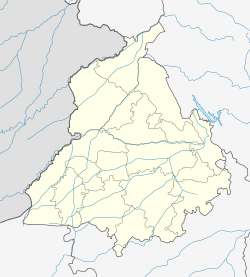- Nizampur, Amritsar
-
Nizampur — village — Coordinates 31°39′4″N 74°59′31″E / 31.65111°N 74.99194°ECoordinates: 31°39′4″N 74°59′31″E / 31.65111°N 74.99194°E Country India State Punjab District(s) Amritsar Nearest city Jandiala Parliamentary constituency Jandiala Population
• Density
4,500
• 250 /km2 (647 /sq mi)
Literacy 60% Time zone IST (UTC+05:30) Area
• Coastline
• 0 kilometres (0 mi)
Climate
Temperature
• Summer
• WinterContinental with four seasons (Köppen)
• 35 °C (95 °F)
• 2 °C (36 °F)Nizampur is a very old village located about 15 km from Amritsar, Punjab, India. The nearest biggest and famous hospital to the village is Sri Guru Ram Das Institute of Medical Sciences & Research, Vallah. The village has breathtaking sites, including green fields. It is has a well-developed sanitation system with a government dispensary in the village. The pincode of the village is 143501.
Contents
Geography
It is located at 31°34′N 74°59′E / 31.56°N 74.99°E.[1]
History
The village is called Nizampur because residents of this village came from Nizampur Deva Singh Wala now in Pakistan, district Sheikhupur during the colonization of Lower Chenab Bar in the early years of 19th century.
Literacy
Literacy rate of the village is about 60%. There is an elementary school in the village where small children study. For higher education students have to go to DAV College, Khalsa College or GNDU University, Amritsar. Lot of boys and girls these days go to Amritsar and other cities to gain higher education or to do jobs.
Fairs and Festivals
Every year in June people celebrate a fair at a holy place in the village called "Baba Sher Singh". The fair is organized with sports like Kabaddi and Wrestling. This fair is on 26 July ( 10th of Haar according to desi calendar). History of this place is that there used to live a priest called Sher Singh. One night some thieves came to steal his cow. But whenever they cross the border of that place they become blind and when they move few steps behind again they gain their visibility. They repeated it several times but same thing happened again and again. From that day the priest gained popularity and thus people arrange the fair to memorize Baba Sher Singh. There is another religious historical place in the village called " Baba Dhora Wala". The fair on this place is on 28 July (12th of Haar according to desi Calendar).
Popular Games
Village has a registered sports club called "Shaheed Bhagat Singh Sports and Youth Club". The village boys play a number of games which are as follows: a)Kabaddi: Kabaddi is believed to have originated from the tribe of Kadirs who thought of themselves to be great champions of sport.In 1938 it was introduced in Olympic Games.Kabaddi is a very enthusiastic game which requires a lot of stamina and reflexes. b)Kho Kho: This game is played by both boys and girls. It is very popular and interesting game.
c)Football: Village boys can be often seen playing football in the village ground.d)Cricket: Cricket has become a very famous sport now. In the past village boys didn't like cricket and very few people were interested in cricket but now it has gained importance and you can see boys playing cricket in ground and on streets as well. e)Gulli Danda:This is a very rare game played in rural towns and villages of India.
f)Bandar Killa: This game is played by four or more children. Firs the children do a pugun pugayee(a kind of toss without a coin). The one who loses the pugun pugayee becomes bandar. A circle is drawn on the ground and every player places his chappals(shoes) in the circle. Then the bandar stands in the circle and all the other players have to steal the chappals from the circle without being caught. If the bandar touches you while you are stealing then you have to be the Bandar. If the Bander can't get hold of anyone & everyone gets away with their pair of chapliyaan, then he is regarded as a true Bander (loser).
g)Pithu Garam: It is an outdoor game. There are two teams each team having equal members. About 5-7 flat stones (theekrian) are piled up. This pile is called Pithu. A member from one team has to hit the pithu from a distance of about 4 meters with a ball and members of the other team get scattered in the field. Each player gets three turns to hit the pitthu and break it. As soon as the player hits and breaks the pitthu, the actual game begins. This is when one team tries to rebuild the pitthu and 2nd team stops them from doing so, by hitting them with the ball.
The player gets out if the ball touches him/her, but if he/she succeeds in making the pitthu first, then that team gets a point. In this way the game continues till all the children have got their turns to hit the pitthu. The team that makes more pitthus is the winner
h)
Population
The village has a population of approx. 6500 with more males as compared to females.
References
Categories:- Amritsar
- Villages in Amritsar district
- Punjab (India) geography stubs
Wikimedia Foundation. 2010.


